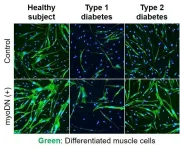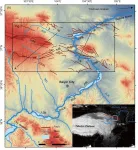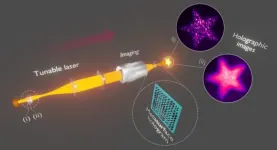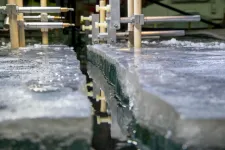(Press-News.org) The Manchester Arena terrorist bomb attack in 2017 exposed flaws in the response of emergency services that could be addressed with a new three-phase approach, research by the University of Bath School of Management shows.
Current government guidelines outline a two-phase structure of 'response and recovery', which researchers discovered hampered effective communication between agencies, created over-reliance on centralised Police decision-making, and inhibited other services' ability to take initiative earlier in an emergency.
"To better prepare responders for emergencies we recommend a three?phase structure of 'response/resolve/recovery' is introduced in place of the current guidelines that outline a two?phase structure of response and recovery. Introducing the 'resolve' phase would allow and encourage other emergency services to act earlier and more effectively," said Dr Olivia Brown of the University of Bath.
Brown and her co-researchers from Lancaster University studied communication and coordination between emergency services during the response to a simulated terrorist incident. They worked with 30 commanders from 11 agencies, including the Police, Fire and Rescue, Ambulance, Military and local and central government.
They studied three phases: 1 - when the incident was ongoing; 2 - 48 hours after the incident; and 3 - three weeks after the incident.
Brown said communications were dominated by the Police in the first phase - a typical and sensible approach in the immediate aftermath of an incident where there remained a threat to life. However, they discovered that even after that threat had been resolved, other agencies became overly reliant on the Police to maintain the communication network, hampering the emergency response. And the Police struggled to act on important information from their emergency service partners.
"Our findings suggest that the Police were so focused on delivering the overall strategy of the response that they failed to attend to important information provided by other agencies and to manage the information flow across the network. This ultimately disrupted coordination and caused delay and uncertainty," she said.
Brown said a similar phenomenon was noted in the report reviewing the Manchester Arena attack, in which the demands placed on the Police commander to implement decisions and deal with the immediate aftermath of the explosion contributed to their lack of communication with the Fire Service located at a different site. This poor communication contributed to a two-hour delay in the deployment of the Fire Service to the site of the incident, which meant that their skills and expertise could be not be utilised until later on in the response.
Brown said decentralized communication structures should be introduced in the early phases of an emergency to improve decision?making across several specialised and diverse teams. Other agencies needed to be empowered to intervene on their own initiative once Police had addressed any immediate threat to life.
"Take the response to a terrorist incident as an example - the Police are tasked with mitigating any further threat, cordoning off the scene and collecting evidence, whereas the Ambulance service must quickly begin accessing and triaging casualties. An effective response to the incident cannot be achieved by one agency alone and instead rests on the ability of teams to work cohesively under immense pressure," she said.
Brown said the study showed that, as the incident evolved, the involvement of other agencies increased and communication became less centralised. That resulted in improved coordination, more joint decision-making, less uncertainty and a better use of the diverse expertise of all agencies.
Brown said their research showed the three-phase structure of 'response/resolve/recovery' more accurately described the behaviours of responders during emergencies than the existing 'response/recovery' structure outlined in government guidelines.
"Changing procedural guidelines to a three-phase structure may empower other agencies to get involved in decision making before the response transitions into the recovery phase," she said.
Brown suggested 'boundary spanners' - specially assigned team members tasked with managing the flow of communications across teams and having a comprehensive view of an emergency incident from its very beginning - may be one solution to the communication issue.
INFORMATION:
Notes to editors
* For further information please contact Tony Roddam at the University of Bath press office on +44 7971 500460 or press@bath.ac.uk
* The research paper Communication and coordination across event phases: A multi-team system emergency response can be accessed here
University of Bath
The University of Bath is one of the UK's leading universities both in terms of research and our reputation for excellence in teaching, learning and graduate prospects.
The University is rated Gold in the Teaching Excellence Framework (TEF), the Government's assessment of teaching quality in universities, meaning its teaching is of the highest quality in the UK.
In the Research Excellence Framework (REF) 2014 research assessment 87 per cent of our research was defined as 'world-leading' or 'internationally excellent'. From developing fuel efficient cars of the future, to identifying infectious diseases more quickly, or working to improve the lives of female farmers in West Africa, research from Bath is making a difference around the world. Find out more: http://www.bath.ac.uk/research/
Well established as a nurturing environment for enterprising minds, Bath is ranked highly in all national league tables. We are ranked 6th in the UK by The Guardian University Guide 2021, and 9th in both The Times & Sunday Times Good University Guide 2021 and the Complete University Guide 2021. Our sports offering was rated as being in the world's top 10 in the QS World University Rankings by Subject in
Skeletal muscle is the largest organ in the body that accounts for 30 to 40% of body weight and is responsible for multiple functions such as energy metabolism and heat production. However, skeletal muscle mass is reduced in some diabetics, and that muscle loss correlates with mortality. It has been reported that the differentiation of myoblasts, which are the muscle precursor cells, is reduced in diabetic patients, and this is thought to be one of the underlying causes of muscle loss.
Assistant Professor Tomohide Takaya of Shinshu University recently reported that oligo DNA derived from the genome ...
The evolutionary history of fluvial geomorphology is the consequences of combined effects of tectonic, climate, lithology and base level. Previous researches had emphasized tectonic impacts on the fluvial system at the tectonically active region, while lithology and base level get little attention. In addition, the resistance of lithology may cause knickpoint and control the evolutionary history of landscape in relatively stable areas, and difference in local base-level is sufficient to induce drainage reorganization. Nevertheless, it is still unclear how far the lithology and base level affect the evolution of fluvial landforms in tectonically active areas.
In this study, researchers chose the area in the NE Tibet Plateau (Laohu and Hasi mountains) (Figure ...
New research could enable better healthcare for patients with benign tumours of the adrenal glands. Researchers at Lund University in Sweden have identified the levels of cortisol produced by the tumours which are associated with higher mortality rates.
Up to half of benign adrenal tumours produce excessive amounts of the hormone cortisol. Until now, researchers did not know at which levels the cortisol could be harmful or even fatal for the patient.
In a study published in the Annals of Internal Medicine, researchers at Lund University and Skåne University Hospital followed up all patients diagnosed with benign adrenal tumours who came into contact with Skåne University Hospital or Helsingborg Hospital between ...
Metasurface holograms (meta-holograms) are ultra-thin artificial surfaces designed to shape incident light and project it to extremely wide angles. Meta-holograms have opened up numerous possibilities such as light multiplexing, information processing, 3D display, high-density data storage, and optical encoding. Despite of these remarkable advances, the road to practical applications of meta-holograms is hindered by artifacts that originate from strong interactions between the building blocks of the meta-holographic surface and inevitable fabrication defects, ultimately causing distortion and degradation to the holographic image. The small dimensions of the meta-hologram, together with the random nature of fabrication defects, make the artifacts problem ...
GEOLOGY There has long been controversy about whether the world's highest region, Tibet, has grown taller during the recent geological past. New results from the University of Copenhagen indicate that the 'Roof of the World' appears to have risen by up to 600 meters and the answer was found in underwater lava. The knowledge sheds new light on Earth's evolution.
Tibet is referred to as the Roof of the World for good reason. With an average altitude of 4,500 meters above sea level and the world's two highest peaks, Mount Everest and K2, the vast Himalayan mountain range towers higher than anywhere else on Earth.
But the Tibetan plateau's height has been ...
The goal of Kaare Hartvig Jensen, Associate Professor at DTU Physics, was to reduce the need for harvesting, transporting, and processing crops for the production of biofuels, pharmaceuticals, and other products. The new method of extracting the necessary substances, which are called plant metabolites, also eliminates the need for chemical and mechanical processes.
Plant metabolites consist of a wide range of extremely important chemicals. Many, such as the malaria drug artemisinin, have remarkable therapeutic properties, while others, like natural rubber or biofuel from tree sap, have mechanical properties.
Harvesting cell by cell
Because most plant metabolites are isolated in individual cells, the method ...
When do bees sting and how do they organise their collective defence behaviour against predators? An interdisciplinary team of researchers from the Universities of Constance and Innsbruck has provided new insights into these questions. Their study, published in BMC Biology, combined behavioural experiments with an innovative theoretical modelling approach based on "Projective Simulation". It shows that individual bees decide whether to sting - or not - based on the presence and concentration of an alarm pheromone. The scientists suggest that each bee has a likelihood of stinging that is not constant, but shows at least two internal thresholds for the concentration of the pheromone: one to start stinging and one to stop stinging. The computational modelling also revealed how several environmental ...
A long-standing theory assumes that terrestrial plants could only have developed by entering into a symbiosis with fungi, whereby the two organisms exchange resources in a mutually beneficial way. A new study by an international group of scientists has now confirmed this theory. By studying a liverwort species (a bryophyte related to mosses), the scientists succeeded in demonstrating that a lipid transfer takes place between the plant and the fungus similar to that already known to exist in plants with stems and roots - so called vascular plants. The study was led by French researchers from the Centre national de la recherche scientifique (CNRS) and the Université de Toulouse III - Paul Sabatier, in collaboration with the ...
Researchers at Aalto University in Finland have found strong evidence that warm ice - that is, ice very close in temperature to zero degrees Celsius - may fracture differently than the kinds of ice typically studied in laboratories or nature. A new study published in The Cryosphere takes a closer look at the phenomenon, studied at the world's largest indoor ice tank on Aalto's campus.
Understanding how ice breaks is crucial for ensuring safe harbours and bridges in cool climates, as well as transportation through historically ice-heavy regions. As global warming brings changes to once-predictable seasonal conditions, the rules underpinning infrastructure ...
A paper published in the Journal of Clinical Medicine presents the results from a study which examined the use of an infrared thermal imaging camera as a novel non-invasive point-of-care tool for lymphatic filariasis lower-limb lymphoedema.
Thermal imaging has been used for several decades in a wide range of medical disciplines, but this is the first time it has been used for filariasis or any skin neglected tropical disease (NTD).
LSTM's Dr Louise Kelly-Hope led the research. She said: "Infrared thermal imaging presents an innovative and objective method for quantifying clinical change in filarial lymphoedema status by using naturally emitting infrared radiation to capture skin surface temperatures. This ...





